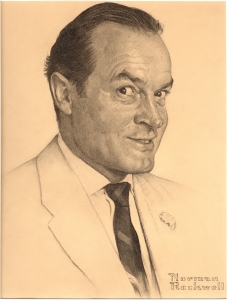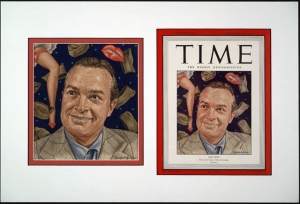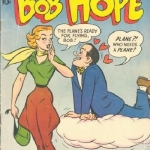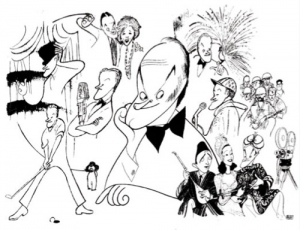
Norman Rockwell (1894-1978) | Portrait of Bob Hope, 1954 | Study for cover illustration for The Saturday Evening Post (February 13, 1954) | Pencil on paper | Norman Rockwell Museum Collection, NRACT.1973.017
Actor and comedian Bob Hope had an extremely recognizable face with his long thin nose, well-defined jaw with its cleft-chin, and expressive eyes and eyebrows. Hope could manipulate his features to give emphasis to his cracks and quips.
Norman Rockwell was commission to create this portrait of Bob Hope in 1954, when the performer, assisted by author Pete Martin, published his biography, Have Tux, Will Travel: Bob Hope’s Own Story. In advance of the book’s publication, the Post published “Bob Hope Tells His Own Story: This Is On Me” in the February 13 issue of The Saturday Evening Post that year. Rockwell’s painted cover portrait of the performer was derived from this drawing. It is the initial drawing that is a fabulous piece of draftsmanship. Done in pencil on paper, this portrait of Hope shows Rockwell’s skill with pencil and his ability to reveal a person’s features and something of his character without delving into caricature.
Bob Hope was immortalized on a Time magazine cover the decade before by cover artist and illustrator Ernest Hamlin Baker (see below). Largely self-taught, Baker created eleven covers for Fortune Magazine between 1929 and 1941 and over three hundred covers for Time between 1939 and 1956. Best known for his portraits of military and world leaders, Baker also created Time covers of other celebrities such as Humphrey Bogart, Charles Laughton, Bert Lahr, and Bing Crosby. His illustration of Bob Hope was published as Time’s cover on September 20, 1943. Baker’s wide-eyed Bob Hope is surrounded by symbols of his performances for the USO: Army forage caps (those soft foldable caps the troops wore), a woman’s short skirt raised to reveal a gartered stocking encased long shapely leg, and red lips surrounding white teeth all floating in the firmament around Hope’s head. His smiling face and wide eyes seem to be fixated on the lady’s leg.
So popular was Bob Hope that even National Periodical Publications’ DC Comics produced a comic book called The Adventures of Bob Hope that ran from 1950 through 1968. Similar to Hope’s film roles, the story lines feature the comic character in some misadventure.
Even American caricaturist Al Hirschfeld (1903-2003) created at least four caricatures of Bob Hope. The first was drawn in the 1940s and is only the comedian’s head. In 1975 Hirschfeld created a head and upper body view of the actor and in the 1990s a slightly different view and finally a caricature that is comprised of vignettes of Bob Hope’s performance career, his USO shows for servicemen and his love of golf.
Besides the size and extreme curl of the tip of Hope’s thin nose, all these images of the actor repeat his raised eyebrows that help us to focus on the exaggeration to his eyes. If the eyes are the windows of a person’s soul, then Bob Hope’s eyes, as Rockwell and others portrayed them, reveal the maniacal inner life that fueled Hope’s performance self.
May 17, 2012
By Joyce K. Schiller, Curator, Rockwell Center for American Visual Studies, Norman Rockwell Museum










